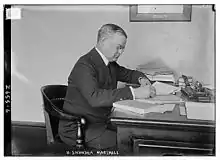Hudson Snowden Marshall
Hudson Snowden Marshall (January 15, 1870 – May 29, 1931) was the United States Attorney for the Southern District of New York from 1915 to 1917.
H. Snowden Marshall | |
|---|---|
 Marshall in 1915 | |
| U.S. Attorney for the Southern District of New York | |
| In office May 7, 1913 – May 1917 | |
| Appointed by | Woodrow Wilson |
| Preceded by | Henry A. Wise (attorney) |
| Succeeded by | Francis Gordon Caffey |
| Personal details | |
| Born | January 15, 1870 Baltimore, Maryland |
| Died | May 15, 1931 (aged 61) Manhattan, New York City |
| Spouse | Isabella Couper Stiles |
| Relations | Somerville Pinkney Tuck (nephew) Alexander J. M. Tuck (nephew) |
| Parent | Charles Marshall |
Early life
Hudson Snowden Marshall was born on January 15, 1870, in Baltimore, Maryland. He was a son of Sarah Rebecca Nicholls (née Snowden) Marshall (1840–1929) and Colonel Charles Marshall (1830-1902), a Confederate Adjutant and aide-de-camp to General Robert E. Lee. He had one sister, Emily Rosalie Snowden Marshall (wife of Judge Somerville Pinkney Tuck),[1] and three brothers, James Markham Marshall, Robert Edward Lee Marshall, and Charles Alexander Marshall.
His paternal grandparents were Maria Rose (née Taylor) Marshall and Alexander John Marshall, nephew of Chief Justice John Marshall. His maternal grandparents were Thomas Snowden and Ann Rebecca (née Nicholls) Snowden. Through his sister, he was uncle to diplomat Somerville Pinkney Tuck,[2] and businessman Alexander John Marshall Tuck.[3]
After primary school in Baltimore, he attended Maupin's School in Ellicott City, Maryland, before attending the University of Virginia, from where he graduated in 1890.[4]
Career
In 1894, he was admitted to the bar and began practicing in Maryland before being chosen at Assistant United States Attorney by William L. Marbury.[4] In May 1896 he became a member of Seward, Guthrie, Morawetz & Steele in New York City. Two years later, he joined the firm of Weeks, Battle & Marhsall as partner of prominent Tammany Hall leader George Gordon Battle and Bartow S. Weeks, who later became a Justice of the New York Court of Appeals.[4] In 1905, Weeks left the firm and James Aloysius O'Gorman, later a U.S. Senator, joined and it was renamed O'Gorman, Battle & Marshall.[5]
In the Spring of 1913, President Woodrow Wilson appointed Marshall the United States Attorney for the Southern District of New York. He served until the end of his term in May 1917. While in office, he said "most of the bankruptcies in New York are dishonest, with perjury rampant. State legislation is needed to supplement the Federal statutes and to give the authorities further power to deal criminally with the prevalent fraud in business failures."[6] Marshall retired from office to resume the practice of law with Parker, Marshall, Miller Auchincloss & Randall with Alton B. Parker, former Chief Judge of the New York Court of Appeals and Democratic nominee for President of the United States in 1904.[7] After Parker's death in 1926, the firm became Marshall & Auchincloss, the other members being Gordon Auchincloss (son-in-law of Edward M. House),[5] and J. Donald Duncan.[4]
Personal life
In 1900 Marshall was married to Isabella Couper Stiles (1872–1956), a daughter of Margaret Wylly (née Couper) Stiles and Robert Mackay Stiles (son of U.S. Representative William Henry Stiles). He was a member of the New York Southern Society, the Virginians, the Maryland Society of New York, the Century Association, the Metropolitan Club, the Calument Club, the Saint Nicholas Society, the New York Athletic Club and the Oakland Golf Club.[4]
He died on May 29, 1931, at his home, 128 East 66th Street, in Manhattan, New York City.[4] After a funeral held at the Church of the Incarnation on East 35th Street, he was buried at Kensico Cemetery in Valhalla, New York.[8] He left a net estate worth $137,812, which went to his widow, Isabel, and on her death, to three nieces and two nephews.[9]
References
- "MRS. SOMERVILLE P. TUCK; Widow of Ex-Presiding Judge of International Court of Egypt". The New York Times. 15 April 1940. Retrieved 28 April 2022.
- "S. PINKNEY TUCK, DIPLOMAT, DEAD; First Envoy to Egypt, 75-- On Board of Suez Canal". The New York Times. 1967-04-23. ISSN 0362-4331. Retrieved 2019-09-27.
- "ALEXANDER J. TUCK DIES IN GENEVA AT 62". The New York Times. 19 March 1955. Retrieved 28 April 2022.
- "H.S. Marshal Dies, Famous as Lawyer. Federal Attorney in Pre-War Days of Neutrality Had Been Ill for Several Months. An Enemy of German Spies. Got 100 Indictments Against Secret Agents. Broke Up Capt. Boy-Ed Passport Plot. Eulogized by G. G. Battle. Of Famous Ancestry. Had Important Litigation. His Work Against Spies". New York Times. May 30, 1931. Retrieved 2015-01-03.
- Times, Special to The New York (24 March 1917). "AUCHINCLOSS MAY SUCCEED MARSHALL; President Said to Have Picked House's Son-in-Law for U.S. Attorney Here. HEAR MARSHALL WILL QUIT Government Prosecutor Said to Have Indicated His Intention of Resigning Next Month". The New York Times. Retrieved 5 May 2022.
- ""MOST OF NEW YORK'S BANKRUPTCIES ARE DISHONEST"; Fraud and Perjury Rampant in a Shockingly Large Percentage of Them, According to H. Snowden Marshall, U.S. District Attorney for Southern District of New York". The New York Times. 4 January 1914. Retrieved 5 May 2022.
- Times, Special to The New York (17 December 1916). "SNOWDEN MARSHALL TO QUIT NEXT APRIL; United States District Attorney Will Resume Law Practice When Term Expires". The New York Times. Retrieved 5 May 2022.
- "NOTABLES MOURN SNOWDEN MARSHALL; Large Gathering at Funeral of Former Federal District Attorney. TRIBUTE BY BENCH AND BAR Several Associations Are Represented--Distinguished MenAmong Honorary Bearers". The New York Times. 2 June 1931. Retrieved 5 May 2022.
- "H.S. Marshall Had $137,812". The New York Times. April 25, 1934. Retrieved 5 May 2022.